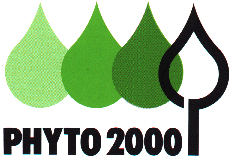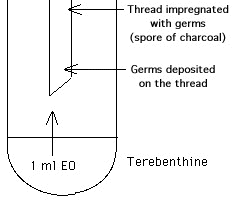
 | ANTIBIOTICS | |||||||||||||||||||||||||||||||||||||||||||||||||||||||||||||||||||||||||||||||||||||||||
To determinate (in vitro) which Essential Oils are to be considered.
The choice of using certain Essential Oils will be determined by various criteria gathered from the Aromatogram - same as in the case of an Antibiogram.
As there is no specific terrain* - there is no specific Aromatogram of a Terrain.
* Terrain is the potential make-up of the genetic elements which have modeled the organism in a certain structured neuro-endrocrinal state, and a particular functional structure which is a result of these genetic elements.
The designated Essential Oils by the Aromatogram are an indication of their antibacterial properties in vitro against a germ considered.
Only the careful study of all other properties of an Essential Oil will allow the selective choice of the proper Oil to be prescribed for a specific and effective treatment of a patient.
The clinical evaluation will permit an effective treatment.
For each antibiotic tested, the disc is impregnated with a specific dose near the M.l.C. (Minimal Inhibiting Concentration) and adjusted by the graduation of the diffusion in the media of the tested molecules.
The disc is impregnated with an identical dose of the Essential Oils to be tested. The E.O. dose is 100 times superior to the strongest M.l.C. and 10,000 times superior to the weakest M.l.C.
Minimal Inhibiting Concentration :
A measured amount, the weakest possible amount of a therapeutlc usage capable of inhibiting the proliferation of the germ under study without interference in the course of action.
-1881 Koch

- 1887 Chamberland (Vapor phase
- 1910 Using Phenol as Reference
Antimicrobial strength
- 1919 Gattefosse
- 1920---->1937
Courmont - Morel - Rochaix
E.O.'s In the vapor state
E.O.'s in Alcoholic Solution
- 1949 Schroeder - Messing
Culture disks - culture media (gelose)
Same principles as antibiogram
- 1962 Sarbach
- 1973 Pellecuer - Duraffourd / S.F.P.A
- 1976 Simon de Buochberg
- 1979 Pierre Lapraz (MD) Thesis of Medicine
In 108 cases, 2 germs have been isolated and tested together in vitro.
The most frequently occurring similarities are as follows :
A total of 26 combinations at 2 germs each.
In 19 cases, 3 germs were isolated and jointly tested :
50 Essential Oils from Angelica to Ylang Ylang were tested with the Aromatogram.
The following table shows the effectiveness of the oils on a variety of germs studied, by indicating one, two, or three crosses.
| Angelica | Lemon | Juniper | Peppermint | Savory |
| Aspic | Citronella | Geranium | Myrtle | Sassafras |
| Basil | Civet | Ginger | Neroli | Sage |
| Bergamot | Copahu | Clove | Niaouli | Wild Thyme |
| Cajeput | Coriander | Hop | Nutmeg | Turpentine |
| Camomile | Cumin | Hyssop | Origanum | Thyme |
| Cinnamon | Cypress | Laurel | Petitgrain | Vacc. Myrtilius |
| Carvi | Tarragon | Lavender | Pine | Verneba |
| Cedar | Eucalyptus | Lemon Grass | Rosemary | Parsley |
| Chenopode | Fennel | Mace | Sandalwood | Ylang Ylang |
Note : Essential Oil of Savory was introduced later in our studies (according to Professor Pellecuer of Montpellier). The Essential Oil was tested 153 times in 268 cases cited.
The results of 268 cases with 15 of the Essential Oils used most frequently :
| ESSENTIAL OIL | % EFFECTIVENESS IN VITRO | PERCENT OF EFFICIENCY |
| Origanum | 86,31 | 88,43 |
| Cinnamon | 79,85 | 85,83 |
| Savory | 67,32 | 75,16 |
| Clove | 50,24 | 56,34 |
| Lavender | 41,91 | 49,62 |
| Cajeput | 39,42 | 45,89 |
| Pine | 38,43 | 43,65 |
| Geranium | 26,99 | 29,85 |
| Myrtle | 25,24 | 30,59 |
| Eucalyptus | 24,25 | 27,61 |
| Petitgrain | 18,15 | 21,64 |
| Aspic | 17,41 | 20,89 |
| Tarragon | 15,04 | 17,91 |
| Lemon | 13,68 | 16,41 |
We have described a report about the absolute effectiveness of the Essential Oil, that is 3 crosses in all cases studied.
We have then determined the percentage of the efficiency in relationship to the number of cases where an effect of the Essential Oil is found in all cases studied.
Like all lab tests, it gives the clinician complementary information such as: